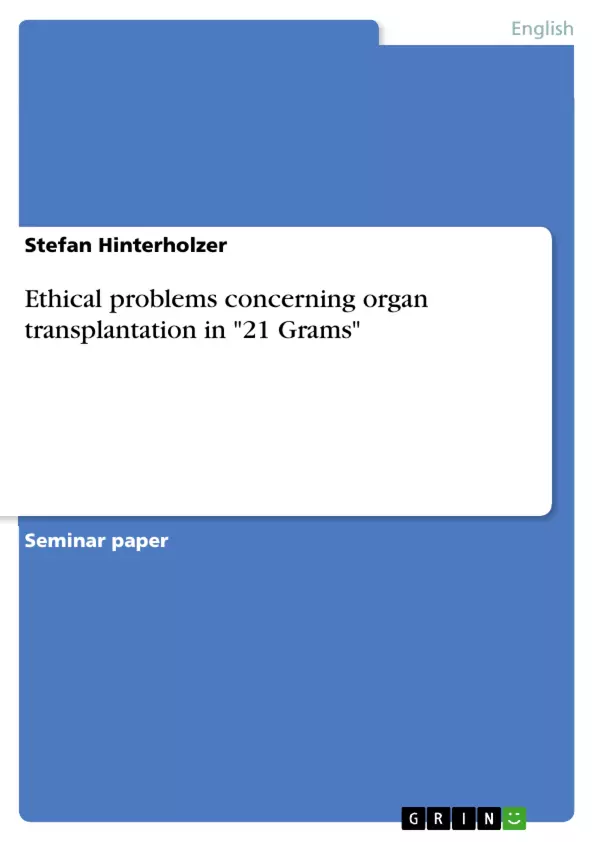"How many lives do we live? How many times do we die? They say we all lose 21 grams... at the exact moment of our death. Everyone. And how much fits into 21 grams? How much is lost? When do we lose 21 grams? How much goes with them? How much is gained? How much is gained? Twenty-one grams. The weight of a stack of five nickels. The weight of a hummingbird. A chocolate bar. How much did 21 grams?"
Paul Rivers leaves us with all these questions before he dies, and in fact, we need all these questions in order to reach a deeper understanding and to make sense of the movie. So, how much do 21 grams weigh? And what are these 21 grams. It is tempting to give a relatively simple answer from a medical or religious perspective. We may say that gases exhaust from our body or even that the soul escapes from the body when we die. But this movie goes a step further.
These 21 grams apparently weigh so little but in the end weigh a lot. These 21 grams are the happiness of a family, the target of revenge, the reason for struggle, they are life itself. So our lives are dependent on these 21 grams, which shows that life is really fragile. And this leads us to the topic of this paper: organ transplantation. Organ transplantation gives us the possibility to save another person’s life when our life is already over.
For many people it is self-evident to donate an organ when someone else’s life can be saved through that, and it may seem that there are no real problems or questions concerning organ transplantation, but there are. Organ transplantation is a much more controversial issue as most people might believe and there are definitely a number of ethical problems concerning organ transplantation. The aim of this paper is to analyze Alejandro González Iñárritu’s movie 21 Grams and to describe the problems and questions connected with organ transplantation that come up. In order to provide a solid basis for the analysis, necessary background information will be presented and connected with the movie. First of all, the director will be presented briefly. Then, general questions and problems concerning organ transplantation in 21 Grams will be discussed and finally more complex issues (decision making, psychological problems and interest groups) will be dealt with.
Inhaltsverzeichnis (Table of Contents)
- Introduction
- Alejandro González Iñárritu's
- Definitions and General Problems
- Definitions
- Requirements for Heart Transplantation
- Organ Shortage
- Decision Making
- The Decision to Donate an Organ
- The Role of Relatives
- The Decision to Receive an Organ and Medical Treatment
- Psychological Problems
- Research
- Identity Confusion
- Interest Groups
- The Organ Recipient
- The Deceased Donor Organ
- The Donor's Relatives
- Conclusion
Zielsetzung und Themenschwerpunkte (Objectives and Key Themes)
This paper aims to analyze Alejandro González Iñárritu's movie 21 Grams and explore the ethical problems surrounding organ transplantation that are presented in the film. To provide a comprehensive analysis, the paper will begin by introducing the director and then move on to discuss general problems and questions related to organ transplantation. It will then delve into more complex issues such as decision making, psychological implications, and the interests of various parties involved.- The ethical dilemmas of organ transplantation
- The decision-making process involved in organ donation and transplantation
- The psychological impact of organ transplantation on recipients and donors' families
- The conflicting interests of various stakeholders in organ transplantation, including recipients, donors' families, and medical professionals
- The representation of these themes through the narrative structure and character development in 21 Grams
Zusammenfassung der Kapitel (Chapter Summaries)
The introductory chapter sets the stage by presenting the film's central question – the significance of the 21 grams lost at death. It highlights the fragility of life and the ethical implications of organ transplantation. The chapter then briefly outlines the paper's objectives and structure. Chapter 1 provides a concise biography of Alejandro González Iñárritu, emphasizing his distinctive non-linear narrative style and his thematic focus on shattered lives, interconnected by a shared experience. Chapter 2 defines organ transplantation and differentiates between living and cadaveric organ donation. The focus is on cadaveric organ donation, as this is the relevant context for the analysis of 21 Grams. Chapter 3 delves into the decision-making process surrounding organ transplantation. It examines the complexities involved in the decision to donate, the role of relatives, and the decision to receive an organ and undergo medical treatment. Chapter 4 explores the psychological implications of organ transplantation. It discusses research findings on the emotional impact of the procedure and addresses the phenomenon of identity confusion. Chapter 5 analyzes the conflicting interests of different groups involved in organ transplantation. It examines the perspectives of the organ recipient, the deceased donor organ, and the donor's relatives.Schlüsselwörter (Keywords)
The paper examines organ transplantation, particularly cadaveric organ donation, in the context of Alejandro González Iñárritu's film 21 Grams. Key themes include the ethics of organ transplantation, decision-making processes, psychological impact, identity confusion, and the interests of various stakeholders, such as the recipient, the deceased donor, and the donor's family.- Citation du texte
- Stefan Hinterholzer (Auteur), 2008, Ethical problems concerning organ transplantation in "21 Grams", Munich, GRIN Verlag, https://www.grin.com/document/114102



